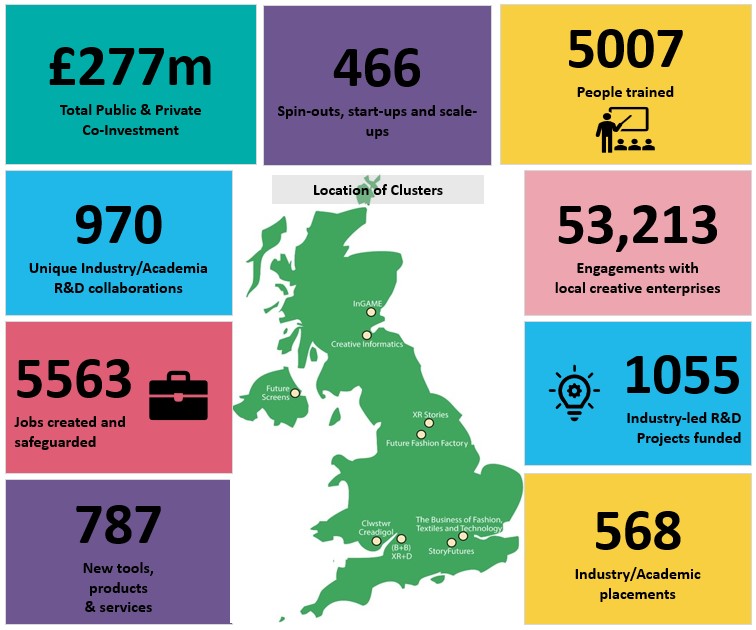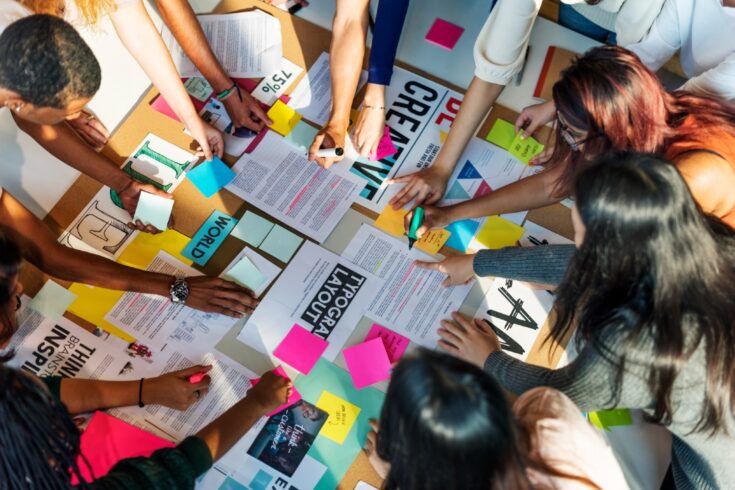When I started in UK Research and Innovation (UKRI), I was told that the creative industries would be the most surprising and fascinating elements of my job.
How right this was. Together with Andrew Chitty and a remarkable team, my predecessor Andrew Thompson had won the case for nine clusters as part of the Industrial Strategy Challenge Fund, and to that we added a clutch of demonstrators called Audience of the Future.
Where the clusters began…
Getting to know these projects took me into extraordinary worlds. Immersive experiences, high end fashion technology, cutting edge gamification all driven by wildly imaginative content production.
But that wasn’t all. Each cluster had an intimate relationship with its place. I came to realise that the clusters were the most innovative of grant mechanisms, and were fulfilling beyond expectation something UKRI was designed to achieve.
Funding had been devolved to an anchor institution, a university, which had used its capacity to aggregate around it, start-ups and existing small and medium-sized enterprises, for and with which it developed skills, created and safeguarded jobs, and, critically attracted co-investment.
The statistics are remarkable.
Infographic: the Creative Industries Clusters programme in numbers up to March 2024

Credit: AHRC
Description of Creative Industries Clusters programme infographic
What: a five-year, £56 million investment launched in November 2018, funding nine creative research and development (R&D) partnerships (clusters) and a Policy and Evidence Centre.
Purpose: to accelerate growth in a range of creative sectors including the following industries:
- broadcast and screen
- fashion textiles and technology
- fashion design innovation
- data and design
- animation and videogames
- digital storytelling and creative audio visual
How: by bringing together a range of educational and commercial partners to undertake applied research of relevance to each cluster.
The programme in numbers:
- total public and private co-investment: £277 million
- spin-outs, start-ups and scale-ups: 466
- people trained: 5,007
- unique industry or academia R&D collaborations: 970
- engagements with local creative enterprises: 53,213
- jobs created and safeguarded: 5,563
- industry-led R&D projects funded: 1,055
- new tools, products and services: 787
- industry or academic placements: 568
Figures are subject to change on completion of the programme and final reporting.
Location of clusters:
- InGAME: Dundee
- Creative Informatics: Edinburgh
- Future Screens: Belfast
- XR Stories: York
- Future Fashion Factory: Leeds
- Clwstwr Creadigol: Cardiff
- (B+B) XR+D: Bristol and Bath
- The Business of Fashion, Textiles and Technology: London
- StoryFutures: Surrey
What the programme has achieved so far
What the clusters achieved was to show how arts and humanities can be at the forefront of innovation, content production, job creation and a deep engagement with place.
The clusters worked, I believe, because we trusted the local teams to find novel and adaptable solutions to their own challenges. The experience forced universities to reimagine what they could achieve, and the success attracted the attention of policymakers and creative industry experts across the UK and beyond.
It is a testament to the strength of the original clusters that each has gone on to further success and solidified their role in their regions and win further grant money. Four of the clusters are involved in the next major AHRC investment, Convergent screen technologies and performance in realtime (CoSTAR), a national capability for virtual screen production which will transform the industry through democratising technology and revolutionising the way we experience film, TV and much besides.
Programme evaluation
And we can see from the evaluation of the clusters, conducted by Frontier Economics and BOP Consultancy that the clusters have made a significant contribution to the overall growth of creative industries in the UK, as one of the UK’s fastest growing industrial sectors.
From 2010 to 2019 the creative industries grew more than 1.5 times faster than the wider UK economy and in 2021 they generated £108 billion in economic value. In 2021, they employed 2.3 million people, a 49% increase since 2011.
We can show how the co-investment, expert communication and geographic distribution of our Creative Industries Clusters delivers on the UK’s ambitions for this high-growth sector, attracting private investment and creating highly skilled jobs.
Moreover AHRC, through the Creative Industries Policy and Evidence Centre, continues to offer compelling analysis for the value of the creative industries in fostering cluster activities across the country, including the development of megaclusters such as the Western Gateway and Northern Creative Corridor.
The future of the Creative Industries Clusters programme
So it is a delight to be able to announce the relaunch of our clusters programme. This time we will need to be even more ambitious and adventurous. We are committed not simply to repeat what we have done before but to rethink the Creative Industries Clusters not just as a singular programme but rather as waves of investment using a model which is proven to work.
AHRC has secured an initial £50 million to launch this new wave, and we are developing our proposal in two phases.
In order to relaunch clusters as soon as possible, we have made the choice to hold an initial closed funding opportunity.
This will allow us to recognise the extraordinary quality of applications to our CoSTAR programme, and build on the strong R&D foundations and potential that these demonstrated. But we will insist on moving to new areas of the country, so that we are building strengths right across the UK and extending the benefits of the clusters model to new partnerships and places.
New sectors of the creative economy
From 2025 onwards, we will work with partners to launch phases of new clusters in open competition, to reach more new geographies, and to break into new sectors of the creative economy. Design, architecture, publishing, adtech and music are all areas which were not funded through phase one of the clusters programme, but there are many exciting possibilities to explore across the whole sector.
Our first open funding opportunity will open in spring 2025, so that we are ready to launch our second tranche of new clusters in early 2026.
We will also establish a coordination hub that will provide comms and engagement and enhanced ecosystem support to drive business growth and competitiveness.
Building the local innovation economy
Throughout we will be expecting these clusters to build the local innovation economy. These are intended to develop highly applied research and innovation at high technology readiness levels.
It is our ambition to match the initial investment through other UKRI funds, to embed clusters as a mechanism of devolved funding with a strong expectation of attracting external funding. We believe that creative industries can be a catalyst in a world of increased devolution to greater skills in place, and that these skills will have spill-over benefits into other industries and sectors.
In this way I hope we move from creative industries as something that happens in one part of UKRI to a way of thinking that animates all of UKRI.
Find out more about the latest funding opportunity: Creative Industries Clusters programme (invite only)




